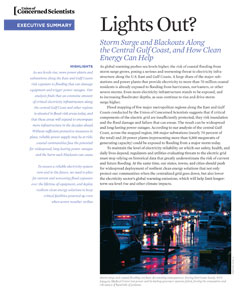Power plants, substations, and electricity supplies are at risk today from storm surge and coastal flooding, especially in locations along the U.S. East Coast and Gulf of Mexico.
In these coastal areas, a hurricane or other large coastal storm can push water inland in a large and damaging storm surge. Crucial electricity infrastructure is exposed to potential flooding and damage during such events.
Widespread blackouts can occur even when only a few pieces of the electric grid succumb to flooding. We've seen it happen with Hurricanes Sandy, Katrina, Rita, and many other coastal storms.
What's more, sea levels are rising, elevating storm surge and increasing the amount of coastal flooding—and the amount of electricity infrastructure at risk—when future storms arrive.
Flood mapping of five major metropolitan regions suggests that if critical components of the electric grid are insufficiently protected, they risk inundation and the flood damage and failure that can ensue.
Outdated historical data underestimate the risks
Flood hazard zones from the Federal Emergency Management Agency (FEMA) often serve as default standards for building and infrastructure flood protection requirements.
To date, however, such zones have been retrospective in nature: they are based on historical data, and do not yet incorporate future sea level rise into their designations. Therefore, using them or other static standards as a basis for locating and designing long-lived electricity infrastructure leaves major investments increasingly vulnerable to shifting realities. For example, over the useful life of the project, sea level rise could widen a flood zone and surround previously unexposed investments.
State or local governing boards can increase the stringency of flood protection requirements beyond those informed by retrospective assessments, but few have taken the first step of conducting their own future risk and vulnerability assessments to spur that change.
Resilient clean energy solutions
To ensure a reliable electricity system now and in the future, we need to plan for current and worsening flood exposure over the lifetime of equipment, and deploy resilient clean energy solutions to keep critical facilities powered up even when severe weather strikes.
Resilient power offers a system that is flexible, can respond to challenges, can quickly recover, and remains available when we need it most. Foremost among such solutions are:
- Renewable energy with energy storage. When coupled with storage systems such as batteries, renewable resources with variable output like solar and wind power are able to provide energy to users even when the sun sets, the wind stops blowing, or the centralized grid goes dark.
- Combined heat and power (CHP) plants. CHP, also called cogeneration, produces electricity and captures thermal energy from a single fuel source; this dual-use approach can greatly increase fuel efficiency while independently supplying heat as well as power to critical facilities.
- Microgrids. These can be self-contained, self-sustaining systems that generate and consume all the energy within a compact geographical “island;” alternatively, they can be interconnected with the broader electric grid and choose when to shift into island mode. During major outages, microgrids can turn into bright beacons of electricity amid widespread darkness.
These clean energy solutions can not only help ensure a reliable electricity supply, they also reduce global warming emissions from fossil fuels. As the largest source of U.S. emissions, the power sector has a critical role to play in reducing emissions and limiting our long-term vulnerability to sea level rise, coastal flooding, and other consequences of global warming.
Utilities can also consider adding more protective measures such as natural and artificial buffers, elevating key infrastructure, and shutting down or moving facilities away from the coastline when upgrades are cost prohibitive.
The increasing threat of climate-related sea level rise and storm surge to our coastal electricity infrastructure is cause for serious concern. Ensuring reliable access to electricity now and into the future requires us to take thoughtful steps to consider the challenges not just of today, but also tomorrow.





